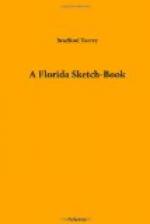My best botanical stroll was along one of the railroads (Sanford is a “railway centre,” so called), through a dreary sand waste. Here I picked a goodly number of novelties, including what looked like a beautiful pink chicory, only the plant itself was much prettier (Lygodesmia); a very curious sensitive-leaved plant (Schrankia), densely beset throughout with curved prickles, and bearing globes of tiny pink-purple flowers; a calopogon, quite as pretty as our Northern pulchellus; a clematis (Baldwinii), which looked more like a bluebell than a clematis till I commenced pulling it to pieces; and a great profusion of one of the smaller papaws, or custard-apples, a low shrub, just then full of large, odd-shaped, creamy-white, heavy-scented blossoms. I was carrying a sprig of it in my hand when I met a negro. “What is this?” I asked. “I dunno, sir.” “Isn’t it papaw?” “No, sir, that ain’t papaw;” and then, as if he had just remembered something, he added, “That’s dog banana.”
Oftener than anywhere else I resorted to the shore of the lake,—to the one small part of it, that is to say, which was at the same time easily reached and comparatively unfrequented. There—going one day farther than usual—I found myself in the borderland of a cypress swamp. On one side was the lake, but between me and it were cypress-trees; and on the other side was the swamp itself, a dense wood growing in stagnant black water covered here and there with duckweed or some similar growth: a frightful place it seemed, the very abode of snakes and everything evil. Stories of slaves hiding in cypress swamps came into my mind. It must have been cruel treatment that drove them to it! Buzzards flew about my head, and looked at me.




